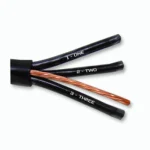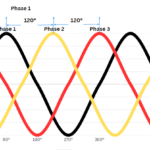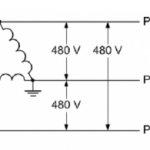208 V three-phase provides standard voltage for light commercial applications. It can power industrial equipment such as data centers, server racks, and control panels. Further applications include air compressors, pumps, and HVAC systems in industrial settings. In this article, we examine the 208V three-phase system, review its wiring diagram, and discuss its color codes.
208V Three-Phase Configuration
Before we discuss the particulars of the 208V three-phase configuration, we must first understand the concept of three-phase configuration. Three-phase provides the most commonly used polyphase system. Three-phase provides three single-phase systems that have similar amplitude and frequency. The voltage wave of this system is displaced 120 electrical degrees apart.
Unlike single-phase systems, a three-phase electrical system such as 208V can still run if one of its single-phase malfunctions. Moreover, the three phases are more efficient since it requires fewer conductors to operate. 208V three phase power systems are also called 208V 3 Phase 4 Wire and 208Y/120V.
Wiring Configuration
The 208V three-phase system has two common wiring configurations. Three-phase, four-wire 120/208V provides a balanced voltage phase system and neutral wire for industrial applications. The three-phase, four-wire 120/240V system, on the other, supplies 240V to any two of the three phases for residential applications. The choice between the wiring configuration depends on the building’s specific electrical power requirements, electrical equipment being used, and codes and regulations present in the location it is being used.
Three-phase, four-wire 120/208 V Wye Configuration
Generally, this is the most common commercial building electric service in the USA. Like any three-phase four-wire wye (star) configuration, it consists of three ungrounded (hot) wires and one neutral wire. The terminal points of the phases (legs) of this wye configuration are designated as line 1, line 2, and line 3. The voltage between any two of the phases L1 to L2, L1 to L3, or L2 to L3 is 208 V. This 208 V yield comes from the product of multiplying a phase voltage and neutral to a constant square root of 3 or 1.732. In addition, the voltage between any of the phases L1, L2, and L3 to the neutral (grounded) conductor is 120 V.
The three-phase, four-wire 120-208 V Wye Configuration system can provide electricity to the following applications:
- 120 V, Two-wire ungrounded to grounded single phase for residential branch circuit purposes and other uses
- 208 V, Two-wire ungrounded to ungrounded single phase for residential branch circuit purposes and other uses
- 208 V, Three-wire, Three phases used for Three-phase motor and loads
- 120V/208V, three-phase, four-wire used for light commercial and small business applications. Also used in 3-wire 3-phase used for 3-phase motors and loads, or as 2-wire ungrounded to ungrounded single phase

Three-phase, four-wire 120/240 V Delta Configuration
Similarly to the wye configuration where the phases (legs) denote as L1, L2, and L3, the lines connect in series forming an equilateral triangle that resembles the greek letter Delta. Any voltage between the two phases is 240V. On the contrary, the center of L2 and L3 grounds at the neutral point which indicates that both lines connected to the neutral have a voltage of 120V. Lastly, the voltage between A and neutral is 208 V.
In contrast to the 120/208 V Wye Configuration, the 120/240V delta configuration uses the concept of High leg Delta. It is a type of 3-phase, 4-wire electric service that supplies 120-208-240 volts to an establishment that allows the use of three different voltage systems. High-leg Delta systems offer voltage flexibility that the wye configuration lacks as it can supply a 240V three-phase connection.
The three-phase, four-wire 120-208 V Wye Configuration system can provide electricity to the following applications:
- 120 V, Two-wire ungrounded to neutral single phase
- 240 V, Two-wire ungrounded to ungrounded single phase
- 240 V, Three-wire, three-phase
- 120/208 V, Three-wire, four-phase

208V Three-Phase Color Codes
Specific color coding of wires provides safety to electricians and practitioners as they can easily determine the specific purposes of the wire. In addition, color coding can easily determine the fault in the wiring of the electrical systems reducing the downtime when it needs repair or maintenance.
Various countries have different sets of required color codes and standards. The United States follows the National Electrical Code (NEC). Individual states and other countries adopt variations of the NEC for their own standards.
Generally, three-phase electricity-supplied circuits use five wires: line 1 wire, line 2 wire, line 3 electrical wire, ground wire, and a neutral wire. Each has corresponding color codes because these conductors in the electrical power systems have different functions and carry different voltages. The table shows the guidelines for the three-phase wire color codes along with their short description.
| Wire | Line 1 | Line 2 | Line 3 | Ground | Neutral |
| USA (Low Voltage) 120/208V 3-Phase | Black | Red | Blue | Green or Bare | White |
| USA (High Voltage) 277/480V 3-Phase | Brown | Orange | Yellow | Green or Bare | Grey |
| Europe and UK | Brown | Black | Grey | Green or Bare | Blue |
It is not necessary to include labels when wiring color codes already exist. However, the means of identification should not include handwritten notifications. Labels shall be durable to withstand the environment of the panel board.



